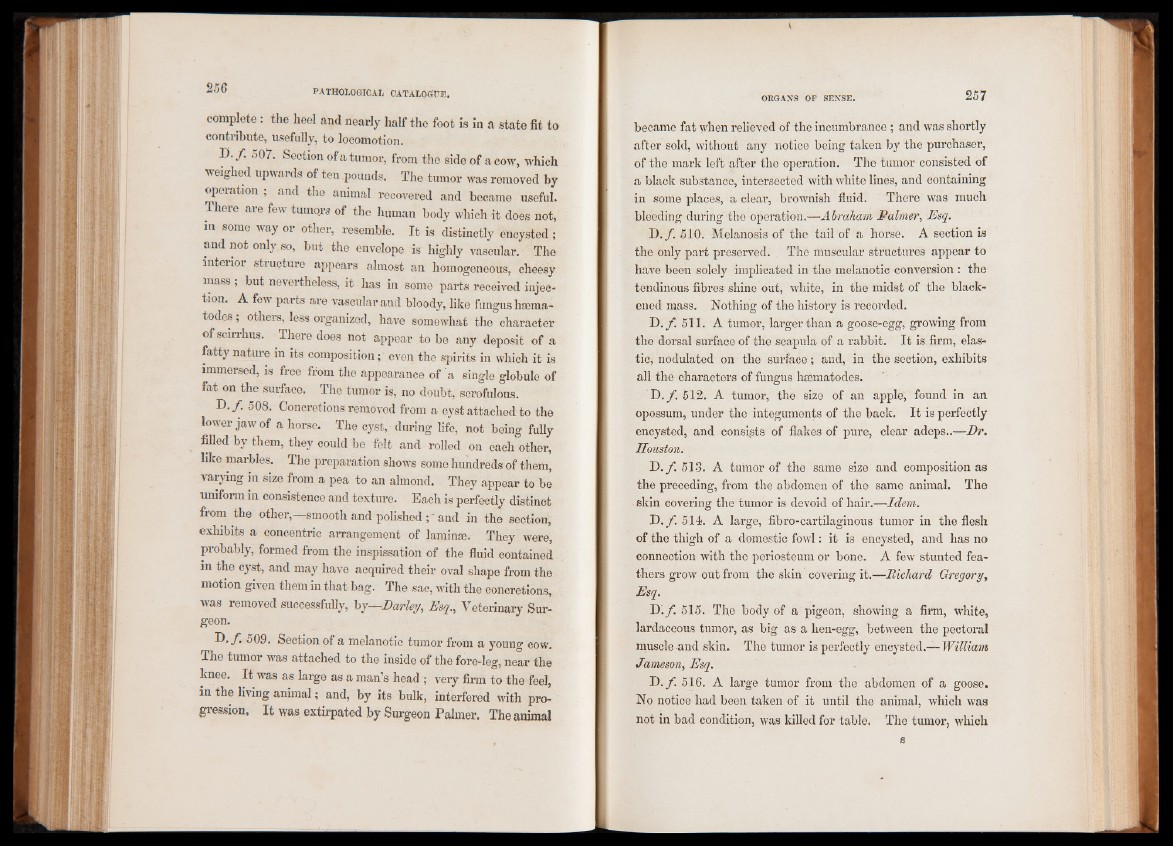
256 PATHOlOGICAIj CATALOGUE,
complete : the heel and nearly half the foot is in a state fit to
contribute, usefully, to locomotion.
B. ƒ. 507. Section of a tumor, from the side of a cow, which
weighed upwards of ten .pounds. The tumor was removed by
opeiation , and the animal recovered and became useful.
There are few tumors of the human body which it does not,
in some way or other, resemble. It is distinctly encysted;
and not only so, but the envelope is highly vascular. The
interior structure appears almost an homogeneous, cheesy
mass; but nevertheless, it has in some parts received injection.
A few parts are vascular and bloody, like fungus hsema-
todes; others, less organized, have somewhat the character
of scirrhus. There does not appear to be any deposit of a
fatty nature in its composition; even the spirits in which it is
immersed, is free from the appearance of a single globule of
fat on the surface. The tumor is, no doubt, scrofulous.
D ./. 508. Concretions removed from a cyst attached to the
lower jaw of a horse. The cyst, during life, not being fully
filled by them, they could be Felt and rolled on each other,
like marbles. The preparation shows some hundreds of them,
varying in size from a pea to an almond. They appear to be
uniform in consistence and texture. Each is perfectly distinct
from the other,—smooth and polished and in the section,
exhibits a concentric arrangement of laminse. They were,
probably, formed from the inspissation of the fluid contained
in the cyst, and may have acquired their oval shape from the
motion given them in that bag. The sac, with the concretions,
wgeaosn .removed successfully, by—Darley, Esq., Veterinary SurD,
ƒ. 509. Section of a melanotic tumor from a young cow.
The tumor was attached to the inside of the fore-leg, near the
knee. It was as large as a man’s head; very firm to the feel,
in the living animal; and, by its bulk, interfered with progression.
It was extirpated by Surgeon Palmer. The animal
ORGANS OP SENSE. 257
became fat when relieved of the incumbrance ; and was shortly
after sold, without any notice being taken by the purchaser,
of the mark left after the operation. The tumor consisted of
a black substance, intersected with white lines, and containing
in some places, a clear, brownish fluid. There was much
bleeding during the operation.—Abraham Palmer, Esq.
D. ƒ. 510. Melanosis of the tail of a horse. A section is
the only part preserved. The muscular structures appear to
have been solely implicated in the melanotic conversion : the
tendinous fibres shine out, white, in the midst of the blackened
mass. Nothing of the history is recorded.
D. f. 511. A tumor, larger than a goose-egg, growing from
the dorsal surface of the scapula of a rabbit. It is firm, elastic,
nodulated on the surface; and, in the section, exhibits
all the characters of fungus hsematodes.
D. f. 512. A tumor, the size of an apple, found in an
opossum, under the integuments of the back. It is perfectly
encysted, and consists of flakes of pure, clear adeps..—Dr.
Houston.
D ./. 513. A tumor of the same size and composition as
the preceding, from the abdomen of the same animal. The
-skin covering the tumor is devoid of hair.—Idem.
D. ƒ. 514. A large, fibro-cartilaginous tumor in the flesh
of the thigh of a domestic fowl: it is encysted, and has no
connection with the periosteum or bone. A few stunted feathers
grow out from the skin covering it.—Richard Gregory,
Esq.D
.f. 515. The body of a pigeon, showing a firm, white,
lardaceous tumor, as big as a hen-egg, between the pectoral
muscle and skin. The tumor is perfectly encysted.— William
Jameson, Esq.
D .f. 516. A large tumor from the abdomen of a goose.
No notice had been taken of it until the animal, which was
not in bad condition, was killed for table. The tumor, which
s